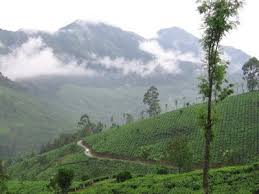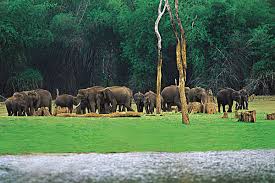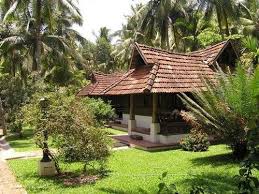 Kerala is located between north latitudes 8 degree 18' and 12 degree 48' and east longitudes 74 degree 52' and 72 degree 22', this land of eternal beauty encompasses 1.18 per cent of the India. The land area of kerala is about 38,863 sqkm, with a total population of 31,838,619. It is about 3 per cent of the country's population. The population density of the state is about 655 people per square kilometer, About 16 per cent of the people live in the cities. Most of the others live in large, semi-urban villages.
Kerala is located between north latitudes 8 degree 18' and 12 degree 48' and east longitudes 74 degree 52' and 72 degree 22', this land of eternal beauty encompasses 1.18 per cent of the India. The land area of kerala is about 38,863 sqkm, with a total population of 31,838,619. It is about 3 per cent of the country's population. The population density of the state is about 655 people per square kilometer, About 16 per cent of the people live in the cities. Most of the others live in large, semi-urban villages.If there is one place in the riveting diversity of India where there is tangible beauty and a phenomenal thing like total literacy, it is in Kerala. Kerala is full of good things. This small State in the southern tip of the Indian peninsula is an easy winner owning to its great mind-blowing landscape and infinity of intriguing customs, high-intensity cultural life and educated public so often dressed in white. From Kasargode to Thiruvananthapuram Kerala is choc-a-bloc with places that attract tourists and travelers from all over the world.
Traditional Hindu temples in Kerala are simple structures made of wood, brick and laterite stone. Often, from afar, the only sign that marks the presence of old temples is a tall, ceremonial flag-mast. The main sanctum hosting the deities -the Sreekovil - is invariably a single storied building of a circular or square plan.
Inside the temples, use of oil lamps in contrast to electrical lights lends an air of serenity and mysticism. Walls of the Sreekovil are rarely left bare, and are instead, covered with intricate, beautiful mural paintings or wood carvings.
 The building base is usually of granite and the walls are of laterite stone masonry covered with lime plaster. The inner framework is of wood. This timber framework supports a conical or pyramidal roof covered with copper tiles. These sloping-roof buildings cope very well with the torrential rains that are a hallmark of Kerala's climate.
The building base is usually of granite and the walls are of laterite stone masonry covered with lime plaster. The inner framework is of wood. This timber framework supports a conical or pyramidal roof covered with copper tiles. These sloping-roof buildings cope very well with the torrential rains that are a hallmark of Kerala's climate.Evolution of temples in Kerala is closely linked to her social and cultural history.
Almost all of the festivals in Kerala include at least one richly caparisoned elephant. Elephants carry the deity during annual festival processions and ceremonial circambulations in the temples. The temple elephants are decorated with gold plated caparisons (nettipattom), bells, necklaces. People mounted on top hold high tinselled silk parasols (muthukuda), swaying white tufts (venchamaram) and peacock feather fans (aalavattom) to the rhythm of the orchestra Like most South Indian cuisine, be it seafood or rice and other cereal dishes, the emphasis is on 'healthy food', less use of oil, sugar, and artificial additives, and more use of natural herbs, spices flavorings, and coconut. Spices that flavor the local cuisine of Kerala give it a sharp pungency that is heightened with the use of tamarind.
In the Kerala kitchens, be it of any of the various communities living there, simple methods and the locally available foodstuff are used to dish out mouthwatering delicacies. Even the ordinary tapioca root, for example, becomes a main course when boiled and sautéed with coconut and spices, a snack when sliced fine, salted and fried, and a sweet dish when steamed with coconut and jaggery.
Kerala has a rich repertoire of folk dances. They reflect the temperaments and moods of the localities in music and costumes and are highly developed. Religious colouring is mostly seen in almost all of these folk dances, even in those performed in connection with harvests, sowing of seeds festivals etc. Men alone, some exclusively by women, perform many of these dance forms. There are also dances in which men and women perform together. Most of the folk dances are performed to the accompaniment of songs, which are sung by the dancers themselves or occasionally by a group of musicians. Some are performed to the accompaniment of musical instruments only. In several dances the performers form a circle and clap as they dance. Sometimes, instead of clapping they strike small sticks, which they hold in their hands. The costumes and ornaments are peculiar to the places to which they belong. In these folk dances there is no difference between the performers and the audience. Almost all of these dances are simple but beneath this simplicity are a profundity of conception is a directness of expression, which are of a high artistic order.
 Mehndi or Hina is the application of henna as a temporary form of skin decoration, orginated in India it is most popular in South Asia, the Middle East, North Africa and Somaliland as well as expatriate communities from these areas. It is typically employed for special occasions, particularly weddings. It is usually drawn on the hands and feet, where the color will be darkest because the skin contains higher levels of keratin, with which the colorant of henna, lawsone, enters a permanent bind
Mehndi or Hina is the application of henna as a temporary form of skin decoration, orginated in India it is most popular in South Asia, the Middle East, North Africa and Somaliland as well as expatriate communities from these areas. It is typically employed for special occasions, particularly weddings. It is usually drawn on the hands and feet, where the color will be darkest because the skin contains higher levels of keratin, with which the colorant of henna, lawsone, enters a permanent bind
No comments:
Post a Comment